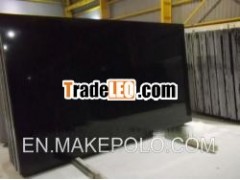Description:
Resists stains, Smooth texture, Durable, Excellent finish, Easy tofix and clean.Ideal For : Any Home & Commercial Uses
Granite (pronounced ) is a common and widely occurring type ofintrusive, felsic, igneous rock. Granites usually have a medium tocoarse grained texture. Occasionally some individual crystals(phenocrysts) are larger than the groundmass in which case thetexture is known as porphyritic. A granitic rock with a porphyritictexture is sometimes known as a porphyry. Granites can be pink togray in color, depending on their chemistry and mineralogy. Bydefinition, granite has a color index (i.e. the percentage of therock made up of dark minerals) of less than 25%. Outcrops ofgranite tend to form tors, and rounded massifs. Granites sometimesoccur in circular depressions surrounded by a range of hills,formed by the metamorphic aureole or hornfels.
Granite is nearly always massive (lacking internal structures),hard and tough, and therefore it has gained widespread use as aconstruction stone. The average density of granite is locatedbetween 2.65[1] and 2.75 g/cm3, its compressive strength usuallylies above 200 MPa and its viscosity at standard temperature andpressure is 3-6 • 1019 Pa·s.[2]
The word granite comes from the Latin granum, a grain, in referenceto the coarse-grained structure of such a crystalline rock.
Granitoid is used as a descriptive field term for general, lightcolored, coarse-grained igneous rocks for which a more specificname requires petrographic examination.[
Mineralogy
Orbicular granite near the town of Caldera, northern ChileGraniteis classified according to the QAPF diagram for coarse grainedplutonic rocks and is named according to the percentage of quartz,alkali feldspar (orthoclase, sanidine, or microcline) andplagioclase feldspar on the A-Q-P half of the diagram. True graniteaccording to modern petrologic convention contains both plagioclaseand alkali feldspars. When a granitoid is devoid or nearly devoidof plagioclase the rock is referred to as alkali granite. When agranitoid contains <10% orthoclase it is called tonalite;pyroxene and amphibole are common in tonalite. A granite containingboth muscovite and biotite micas is called a binary or two-micagranite. Two-mica granites are typically high in potassium and lowin plagioclase, and are usually S-type granites or A-type granites.The volcanic equivalent of plutonic granite is rhyolite. Granitehas poor primary permeability but strong secondarypermeability.
Chemical composition
A worldwide average of the chemical composition of granite, byweight percent:[4]
The Stawamus Chief is a granite monolith in British ColumbiaSiO2 —72.04%
Al2O3 — 14.42%
K2O — 4.12%
Na2O — 3.69%
CaO — 1.82%
FeO — 1.68%
Fe2O3 — 1.22%
MgO — 0.71%
TiO2 — 0.30%
P2O5 — 0.12%
MnO — 0.05%
Occurrence
Granite is currently known only on Earth where it forms a majorpart of continental crust. Granite often occurs as relativelysmall, less than 100 km² stock masses (stocks) and in batholithsthat are often associated with orogenic mountain ranges. Smalldikes of granitic composition called aplites are often associatedwith the margins of granitic intrusions. In some locations verycoarse-grained pegmatite masses occur with granite.
Granite has been intruded into the crust of the Earth during allgeologic periods, although much of it is of Precambrian age.Granitic rock is widely distributed throughout the continentalcrust of the Earth and is the most abundant basement rock thatunderlies the relatively thin sedimentary veneer of thecontinents.
Origin
Granite is a common and widely occurring type of intrusive, felsic,igneous rock. Granites usually have a medium to coarse grainedtexture. Occasionally some individual crystals (phenocrysts) arelarger than the groundmass in which case the texture is known asporphyritic. A granitic rock with a porphyritic texture issometimes known as a porphyry. Granites can be pink to gray incolor, depending on their chemistry and mineralogy. By definition,granite has a color index (i.e. the percentage of the rock made upof dark minerals) of less than 25%. Outcrops of granite tend toform tors, and rounded massifs. Granites sometimes occur incircular depressions surrounded by a range of hills, formed by themetamorphic aureole or hornfels.
Granite is nearly always massive (lacking internal structures),hard and tough, and therefore it has gained widespread use as aconstruction stone. The average density of granite is locatedbetween 2.65[1] and 2.75 g/cm3, its compressive strength usuallylies above 200 MPa and its viscosity at standard temperature andpressure is 3-6 • 1019 Pa·s.[2]
The word granite comes from the Latin granum, a grain, in referenceto the coarse-grained structure of such a crystalline rock.
Granitoid is used as a descriptive field term for general, lightcolored, coarse-grained igneous rocks for which a more specificname requires petrographic examination.[
Mineralogy
Orbicular granite near the town of Caldera, northern ChileGraniteis classified according to the QAPF diagram for coarse grainedplutonic rocks and is named according to the percentage of quartz,alkali feldspar (orthoclase, sanidine, or microcline) andplagioclase feldspar on the A-Q-P half of the diagram. True graniteaccording to modern petrologic convention contains both plagioclaseand alkali feldspars. When a granitoid is devoid or nearly devoidof plagioclase the rock is referred to as alkali granite. When agranitoid contains <10% orthoclase it is called tonalite;pyroxene and amphibole are common in tonalite. A granite containingboth muscovite and biotite micas is called a binary or two-micagranite. Two-mica granites are typically high in potassium and lowin plagioclase, and are usually S-type granites or A-type granites.The volcanic equivalent of plutonic granite is rhyolite. Granitehas poor primary permeability but strong secondarypermeability.
Chemical composition
A worldwide average of the chemical composition of granite, byweight percent:[4]
The Stawamus Chief is a granite monolith in British ColumbiaSiO2 —72.04%
Al2O3 — 14.42%
K2O — 4.12%
Na2O — 3.69%
CaO — 1.82%
FeO — 1.68%
Fe2O3 — 1.22%
MgO — 0.71%
TiO2 — 0.30%
P2O5 — 0.12%
MnO — 0.05%
Occurrence
Granite is currently known only on Earth where it forms a majorpart of continental crust. Granite often occurs as relativelysmall, less than 100 km² stock masses (stocks) and in batholithsthat are often associated with orogenic mountain ranges. Smalldikes of granitic composition called aplites are often associatedwith the margins of granitic intrusions. In some locations verycoarse-grained pegmatite masses occur with granite.
Granite has been intruded into the crust of the Earth during allgeologic periods, although much of it is of Precambrian age.Granitic rock is widely distributed throughout the continentalcrust of the Earth and is the most abundant basement rock thatunderlies the relatively thin sedimentary veneer of thecontinents.
Origin-INDIA
Black Granite supplier







